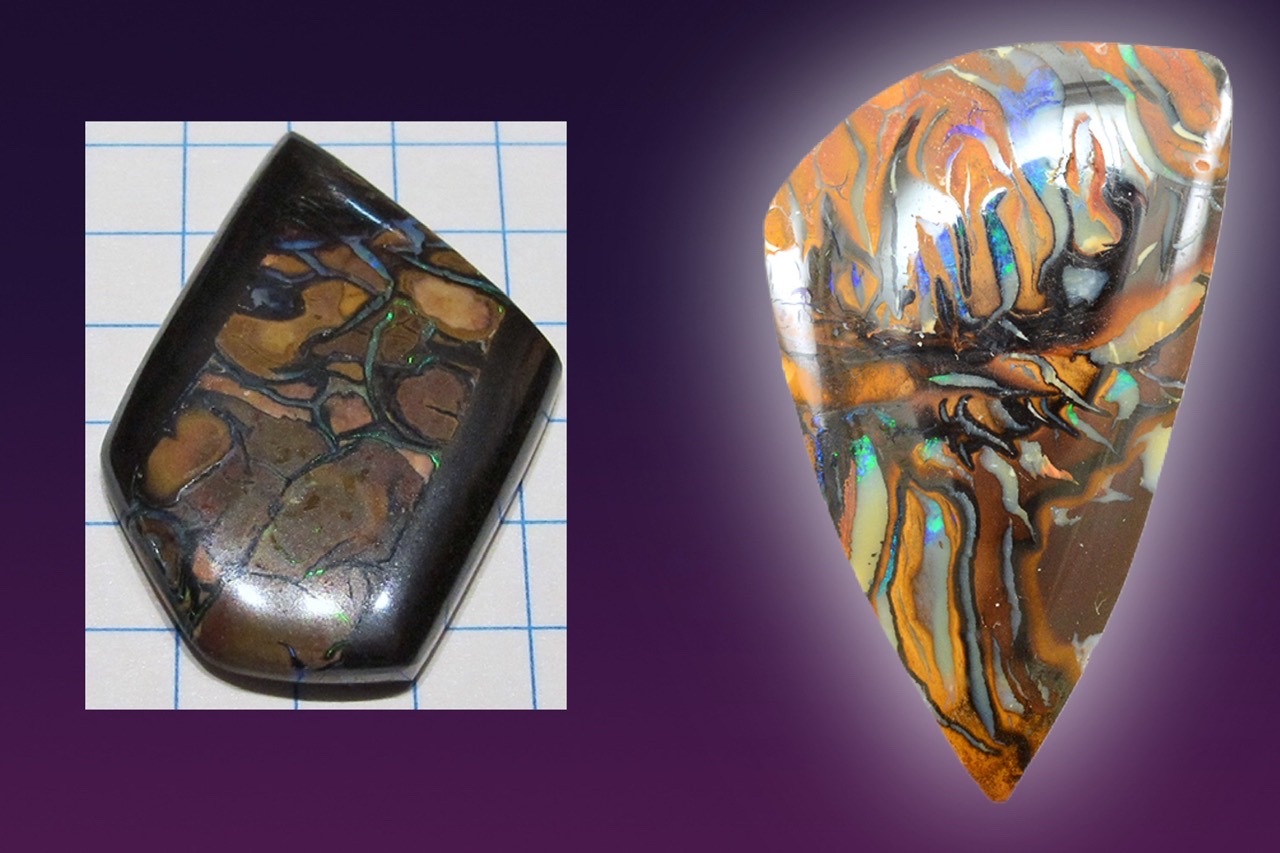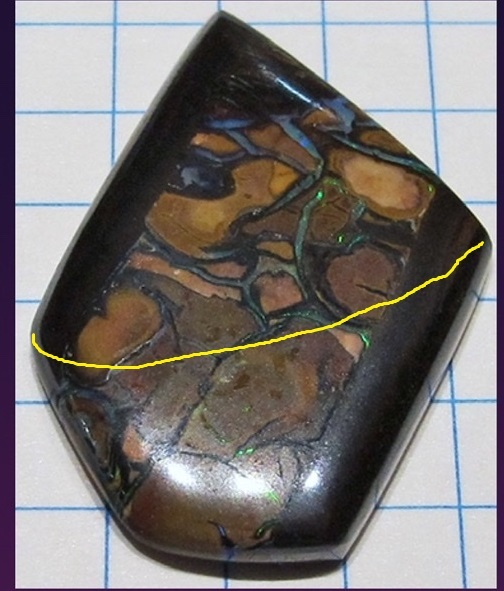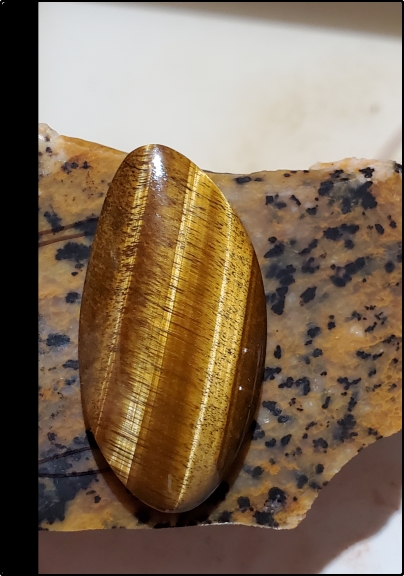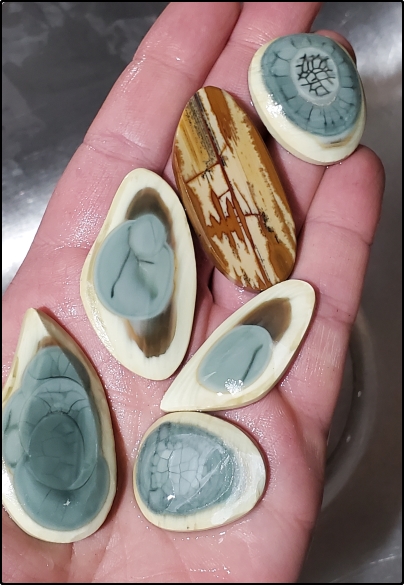|
|
Post by knave on Jan 17, 2020 23:12:25 GMT -5
Many of the cabs that come across this board are freeform style. Usually to bring out the scene or pattern in the rock. I have a natural tendency for symmetry ie. I love a neatly pruned shrub or centered text. Is one preferred above the other? Is it a fashion that comes and goes? FWIW I’m not talking about a jewelry setting but just a cabochon. My 2 cents: a free form can still have a symmetrical flow, and you can see when it is off, and you can almost feel it  . i have a box of them that i throw at my cat when he is making noise when i am trying to take a nap. this ,in turn,is a double fail,because my cat (Ziggy) then proceeds to bat the lumpy cab around the room, making more noise than he was making in the first place. at this point? i then go out to the garage,grouchy from no nap,and make another lumpy,lop sided cab to put in the cat toy box. Lol! Made me laugh, thanks. At the same time, I’ve seen your cabs and even your excellent humor won’t make that BS go down lol. ETA: I need ammunition for the living room naps. Send the extra lumps my way, I’ll even share them with RocksInNJ! |
|
|
|
Post by hummingbirdstones2 on Jan 17, 2020 23:16:03 GMT -5
My two cents here. I know - that's two small steps above worthless, but here it is.
I might try taking off the top left corner and rounding the top into something of a shield shape.
|
|
|
|
Post by Pat on Jan 18, 2020 0:59:22 GMT -5
My brain is freeform. However, some things want to be symmetrical. Symmetry requires obvious perfection. One area out of line ruins it. See rockjunquie ‘s blue speckled cab. It’s just wrong. Freeform also had its needs. Any old shape won’t do. Freeform needs its own symmetry, just not symmetrical symmetry. Lol! |
|
|
|
Post by pauls on Jan 18, 2020 4:05:15 GMT -5
You nailed it there Pat.
Really I think what I am personally looking for is balance, a perfectly symmetrical cab can look wrong if the pattern in the stone throws it out of balance, and of coarse the most lopsided freeform can look perfect if the pattern balances the lumpy look. It's often hard to put your finger on what it is that works, sometimes it doesn't.
To be different I like cabs with pointy bits, I'm doing it for myself so I don't care if it's going to be a bitch to mount in a setting. I have even been known to make wildly lopsided hearts, it can look really awful if not balanced and it needs to be super wonky so it doesn't look like a bad mistake.
|
|
|
|
Post by hummingbirdstones2 on Jan 18, 2020 9:56:08 GMT -5
Well said pauls - let the stone decide what it wants to be. |
|
|
|
Post by Starguy on Jan 20, 2020 18:06:11 GMT -5
knaveSymmetrical ovals and rounds are faster to finish. Freeforms take me more time. Both are equally satisfying. Many findings are calibrated for symmetrical calibrated sizes, i.e 30x40 mm, dime size, silver dollar size, etc.
|
|
|
|
Post by knave on Apr 15, 2020 23:37:05 GMT -5
I purchased this koroit in a lot. The diagonal pattern just doesn't work with the freeform. I call this a freeform fail. The shape waaaay too "freeform". I won't be left with too much when I rework.   |
|
|
|
Post by stardiamond on Apr 16, 2020 0:01:12 GMT -5
To start with:  and then decide if you want to remove the left border. I wouldn't worry about symmetry. |
|
|
|
Post by knave on Dec 31, 2021 14:51:00 GMT -5
It has become important to me that the shape of a cab is intentional.
For me, this means the pattern thickness dome and shape needs to be pleasing to the eye, not just some random shape that appeared after all the fractures were ground off.
Another personal thing, I prefer the more slender or narrow shapes over the chunky ones.
|
|
|
|
Post by stardiamond on Dec 31, 2021 17:52:10 GMT -5
A person tends to cut shapes that are pleasing to them. I don't like circles and ovals. Most of my cabs have a pointy end. There is usually a decision about what to include and exclude. Trying to get too much can create a clunky shape. Given a choice, I go for symmetrical and have a lot of template shapes to choose from. A pattern cannot be forced into a shape and that is why a freeform is the best choice. Design is very important to me. Take a look at these: www.etsy.com/search?q=willow+creek+cabochon&explicit=1&page_type=search&order=price_desc |
|
|
|
Post by knave on Dec 31, 2021 19:26:47 GMT -5
Thanks for that! I see good and bad cabs in those search results.
|
|
fencejumper
Cave Dweller 
Member since May 2021
Posts: 441
|
Post by fencejumper on Dec 31, 2021 21:25:20 GMT -5
Beauty is in the eye of the maker.
Screw what everyone else thinks.
If it makes you smile and feel good?
Keep smiling, and feeling good.
|
|
|
|
Post by rockjunquie on Dec 31, 2021 22:07:18 GMT -5
It has become important to me that the shape of a cab is intentional. For me, this means the pattern thickness dome and shape needs to be pleasing to the eye, not just some random shape that appeared after all the fractures were ground off. Another personal thing, I prefer the more slender or narrow shapes over the chunky ones. I like symmetry and I also like more narrow cabs. However, with the narrow cabs, it's harder to fit in a nice bit of pattern- depending on the stone type. |
|
|
|
Post by rmf on Jan 1, 2022 12:32:09 GMT -5
I use to cut just standard size stones from the classic Red,Blue,Gold template set since that is what most mounts worked with. But I bought a 5 gal bucket of Montezuma Agates and most of them are small and to get the whole pattern I started cutting baroque stones following the outer edge and grinding out the deeper areas. I have all kinds of templates now for different sizes and shapes some are nice and symmetrical and some are not. Beyond symmetry there is the ratio of length to width. I found that some ovals were much more pleasing to me that others. This led to the discovery of the "golden ratio" which is not symmetry but relationship between length and width. Sometime if you have time to go down the rabbit hole search on the "golden ratio human face" you discover those "beautiful people" from Hollywierd frequently have faces that are filled with the golden ratio. It is mind blowing to think that I like an long oval better than a 40x30 oval just because my brain likes that math better. Symmetry plays a part after all we are symmetrical. But it is the "Golden Ratio" that rules them all.
|
|
|
|
Post by holajonathan on Jan 2, 2022 0:03:06 GMT -5
It has become important to me that the shape of a cab is intentional. For me, this means the pattern thickness dome and shape needs to be pleasing to the eye, not just some random shape that appeared after all the fractures were ground off. Another personal thing, I prefer the more slender or narrow shapes over the chunky ones. I don't think anyone wants pattern, thickness, dome, or shape to be random, as in, left to chance. And everyone wants their cabs to look good. A free form is not the opposite of intentional. It does not mean grinding away at random and calling whatever results a free form. At least that's not how most people use the term. A good free form is just as intentional as a template shape. When a template shape provides a good capture, most people use the template. But when no template shape provides a good capture, you can force a template shape -- and make a mediocre cab -- or you can try to capture the area of interest with a free form shape. This is often necessary when working with small slabs, heavily fractured material, or high end material where you want to squeeze as many cabs as possible out of the slab. Although most of my free forms are very much intentional, I have no problem tweaking the shape of a cab in order to remove flaws that show up in the rock as I create the cab. I also tweak the shape while cabbing just to make the cab look better. Sometimes I keep cabs symmetrical as I tweak the shape; other times I do not. Either way, this is a deliberate and not a random process. The template shape is just someone else's idea for a cab shape. But the person who made the template was not looking at your particular slab. When my sense of the ideal cab shape comes into conflict with the template, I trust my aesthetic judgment over the template. Templates save time, but they are not inherently better shapes than anything you or I might come up with on our own. |
|
|
|
Post by holajonathan on Jan 2, 2022 0:20:10 GMT -5
Beauty is in the eye of the maker. Screw what everyone else thinks. If it makes you smile and feel good? Keep smiling, and feeling good. I smile more and feel better when my cabs look good to both me and to others. For example, I like to give my cabs away as gifts to friend and family. I want my friend and family to like these gifts, not for superficial reasons, but because I care about them and love them. If I make a pendant necklace for my mom, I want her to actually like it. And if she does like it, this makes me happy. I get your point, and for the most part, I agree. But sometimes it makes good sense to take into account what other people think as well. |
|
|
|
Post by stephan on Jan 2, 2022 0:21:22 GMT -5
It has become important to me that the shape of a cab is intentional. For me, this means the pattern thickness dome and shape needs to be pleasing to the eye, not just some random shape that appeared after all the fractures were ground off. Another personal thing, I prefer the more slender or narrow shapes over the chunky ones. I don't think anyone wants pattern, thickness, dome, or shape to be random, as in, left to chance. And everyone wants their cabs to look good. A free form is not the opposite of intentional. It does not mean grinding away at random and calling whatever results a free form. At least that's not how most people use the term. A good free form is just as intentional as a template shape. When a template shape provides a good capture, most people use the template. But when no template shape provides a good capture, you can force a template shape -- and make a mediocre cab -- or you can try to capture the area of interest with a free form shape. This is often necessary when working with small slabs, heavily fractured material, or high end material where you want to squeeze as many cabs as possible out of the slab. Although most of my free forms are very much intentional, I have no problem tweaking the shape of a cab in order to remove flaws that show up in the rock as I create the cab. I also tweak the shape while cabbing just to make the cab look better. Sometimes I keep cabs symmetrical as I tweak the shape; other times I do not. Either way, this is a deliberate and not a random process. The template shape is just someone else's idea for a cab shape. But the person who made the template was not looking at your particular slab. When my sense of the ideal cab shape comes into conflict with the template, I trust my aesthetic judgment over the template. Templates save time, but they are not inherently better shapes than anything you or I might come up with on our own. Well said. My freeforms are intentional. Nature often has a say, but it’s not completely random. That wasn’t always the case. I’ve reworked many of my older cabs, which sometimes looked like I was trying to replicate the shape of states |
|
|
|
Post by Rockoonz on Jan 2, 2022 0:25:35 GMT -5
Templates are windows to view stones through, looking for a pattern. Once I see a spot I like I try to let the stone show me that window, with the help of a template to hide the rest. Once I'm happy with it I might use several templates like french curves to lay out something that may or may not end up looking like it ultimately, depending on what surfaces 1 or 2mm down around the edge.
My favorites are the little slabette one cab wonders that are already virtually preforms, a lot of owyhee materials lend themselves to this.
|
|
|
|
Post by holajonathan on Jan 2, 2022 0:38:08 GMT -5
Here are a few recent free forms. I made this one an asymmetrical free form because I thought the asymmetry provided necessary contrast with the extremely uniform pattern in the rock. This isn't a great cab, but I think it looks better than it would as a symmetrical oval or tear drop.  This was a 1" tall slab with nasty matrix on one edge, and unstable quartz crystals on the other. If I had tried to force a template shape over the slab, it would have been a very small cab that did a poor job of capturing the pattern. I ground off all of the nasty matrix and unstable quartz, leaving only the solid agate. Then, I further tweaked the shape to create a symmetrical S shape. This shape was not planned, but the end result was deliberate.  For these two royal imperial jasper cabs, I simply ground down the white border until I framed the orbs in a pleasing way. There was no symmetrical template shape that would have done either of these any justice. Neither shape was precisely planned, but they resulted from a deliberate process.   Just showing some examples of how I think about free forms and why at least half of my cabs are free forms. |
|
|
|
Post by holajonathan on Jan 2, 2022 0:48:55 GMT -5
RockoonzAgreed. Some of my favorites, too. A lot of Owyhee Gem in like you describe, as well as Royal Imperial Jasper, and the smaller nodular agates like Botswana agates, lakers, etc... When I've got little cuts like these, I do not reach for a template.  
|
|

 . i have a box of them that i throw at my cat when he is making noise when i am trying to take a nap.
. i have a box of them that i throw at my cat when he is making noise when i am trying to take a nap.
























